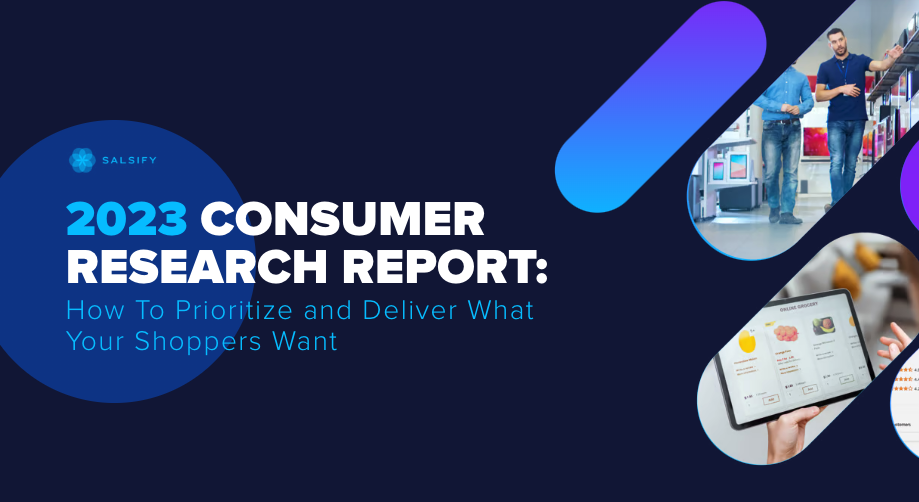

2023 Consumer Research Report
Download our consumer research report to learn how to stay ahead of changing markets and consumer behaviors.
DOWNLOAD REPORTPIM
Manage all product content in one central system of record.
Syndication
Easily syndicate product content to every consumer touch point.
Enhanced Content
Enrich product pages with below-the-fold content and rich media.
Intelligence Suite
Bring AI-powered capabilities directly into your Salsify workflows.
Grocery Accelerator
Leverage the first-ever category-wide PXM accelerator in the grocery industry.
GDSN Data Pool
Synchronize standard supply chain, marketing, and ecommerce attributes globally.
Digital Shelf Analytics
Continuously optimize your organization’s product content syndication.
Catalog Sites
Share secure, on-brand, and always up-to-date digital product catalogs.
Automation and AI
Automate business processes and enhance Salsify workflows with AI.
PXM Platform, Integrations, and APIs
Integrate the PXM platform with the rest of your enterprise systems architecture.
Supplier Onboarding
Accelerate supplier onboarding while ensuring your schema requirements are met.
Product Listing
Sell products faster with Product Listing.
Content Enrichment
Increase online conversions with Content Enrichment.
Automation
Save time and increase operational efficiency with retail automation.
SXM Platform, Integrations, and APIs
Integrate the SXM platform with the rest of your enterprise systems architecture.
Syndication Network
Automate how you exchange product content data to the digital shelf.
Enhanced Content Network
Turn product pages into product experiences with Enhanced Content.
Commerce Platform Integrations
Create winning product experiences everywhere shoppers are, including on owned sites.
GDSN Data Pool
Synchronize standard supply chain, marketing, and ecommerce attributes globally.
Open Catalog
Connect to the digital shelf faster with an open, standardized, and free product catalog.
Resources
Resource Library
Explore our ecommerce resources to get everything you need to win on the digital shelf.
Blog
Read our blog to get actionable insights for navigating changing markets and industry demands.
Webinars
Watch our on-demand ecommerce webinars to gain expert advice and tips from our community of industry leaders.
Customer Blog
Gain the latest tips, industry trends, and actionable ecommerce insights.
Knowledge Base
Investigate our knowledge base to build your Salsify skills and understanding.
API
Examine our comprehensive API and webhook guides to start working with Salsify quickly.

Download the report to get expert insights, consumer research, and top industry trends.

Ecommerce sales volumes are steadily increasing. According to Statisa, ecommerce is predicted to account for nearly a quarter of total global retail sales.
But yearly and quarterly reports don’t tell the whole story. Seasonal sales fluctuations — known as ecommerce seasonality — can impact brand sales and make or break their profitability for the year.
Here’s a breakdown of the basics of retail seasonality in ecommerce, the best and worst months for ecommerce sales, examples of common seasonal impacts, and actionable tips for brands to navigate seasonal fluctuations.
Ecommerce seasonality refers to recurring purchase patterns that occur every year. Holiday shopping is an easy example — in the United States, sales volumes pick up significantly in November with Black Friday and stay strong through post-Christmas sales. In the new year, meanwhile, sales often fall as customers return to work and deal with any debts incurred over the holidays.
Although brands can’t predict exact revenue volumes, the seasonality of customer behavior can help companies plan for regular sales increases or decreases and prepare accordingly.
The best months of the year for ecommerce are November, December, and January. November marks the start of the holiday season in the United States and includes high-volume sales days such as Black Friday and Cyber Monday.
Consumers increase their spending in December, searching for last-minute holiday gifts, and in January, purchasing all the items that are on sale.
February and March tend to be slow months for ecommerce sales because many customers are returning to work after the holiday season, and they’re often focused on reducing spending or paying off any holiday credit card debt.
Ecommerce seasonality falls into three broad categories: holidays, weather, and recurring events.
Common holidays that can help increase ecommerce sales include Black Friday, Cyber Monday, Christmas, and New Year. Other holidays that can boost purchase volumes include Hanukkah, New Year’s, Diwali, and Ramadan.
Businesses may also be able to capitalize on limited-time sales around holidays such as Mother’s Day, Father’s Day, Valentine’s Day, and Halloween.
For brands that sell clothing or outdoor items, weather plays a crucial role. For example, outdoor clothing and gear stores should stock products such as shorts, sandals, and sun hats during the summer. In the winter, jackets, mitts, and warm underlayers are more likely to sell.
It’s also worth noting that brands can create customer interest with end-of-season or even off-season sales.
Non-weather, non-holiday events offer opportunities for ecommerce brands. For example, back-to-school season comes with an uptick in sales volumes for school supplies, clothing, and electronics. In addition, brands can create their own seasonal events with clearance sales for old product stock.
While brands can’t control the impact and outcome of seasonality, they can take steps to better navigate these changes.
Understanding the ebb and flow of monthly ecommerce sales along with the impact of holiday sales can help brands manage seasonality — if they plan accordingly.
This planning often happens during the slower sales months of February and March. It includes a reevaluation of brand messaging and marketing, along with the mapping out of campaigns for specific holidays or seasons.
Brands don’t need to plan for every holiday, however. Instead, it’s worth selecting a few high-priority sales events and then creating social and digital campaigns to drive customer engagement.
Seasons and holidays aren’t universal.
Consider Australia. When the United States experiences summer, Australia has its winter. As a result, seasonal sales campaigns are reversed for these two markets: When you’re selling winter coats in Michigan, you’re marketing shorts and flip-flops in Australia.
Holidays also differ based on geographic location. For example, in the U.K. and Canada, Boxing Day — December 26 — is a popular day for post-Christmas sales. Creating campaigns that incorporate this holiday can help boost regional sales.
Just because you’re in the sales slump of February and March doesn’t mean it’s time to rest on your laurels. Instead, it’s an opportunity to build brand recognition through social media and blog posts and set the stage for upcoming sales events.
It’s also a good time to dig into retail and consumer trend forecasting to see what’s a priority for buyers and what’s next on the market.
It’s also worth taking a look back at the previous year’s seasonal sales to see what worked, what didn’t, and where you can improve.
Equipped with the right data, brands are better equipped to navigate seasonal changes. For example, Salsify’s “2023 Consumer Research” reports that 64% of online shoppers encountered out-of-stock items when shopping over the last three months.
Seasonality often plays a role in these inventory issues; if brands don’t stock up before holiday rushes or post-season sales, they could find themselves losing customers.
There’s a reason for the season. Equipped with solid sales and customer insight and ecommerce trend data, companies are better prepared to make the most of recurring seasonal shifts.

Download our consumer research report to learn how to stay ahead of changing markets and consumer behaviors.
DOWNLOAD REPORTDoug Bonderud (he/him) is an award-winning writer with expertise in ecommerce, customer experience, and the human condition. His ability to create readable, relatable articles is second to none.
Standing out on the digital shelf starts with access to the latest industry content. Subscribe to Below the Fold, our monthly content newsletter, and join other commerce leaders.